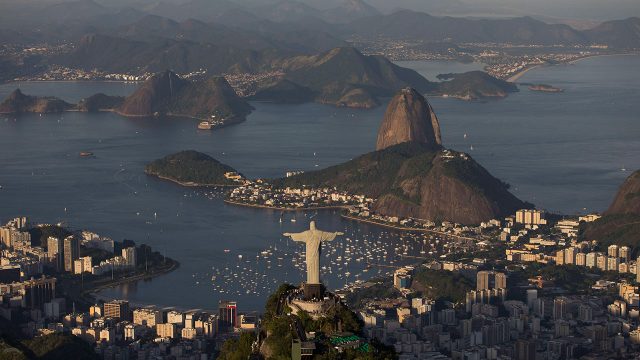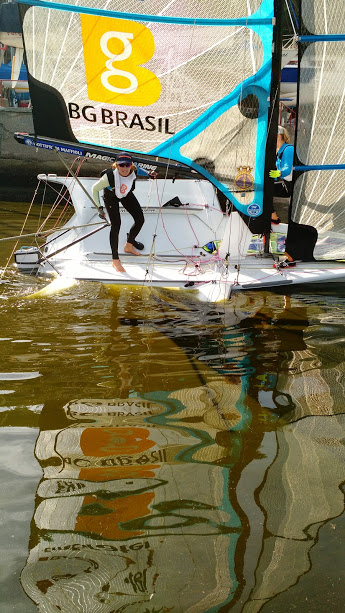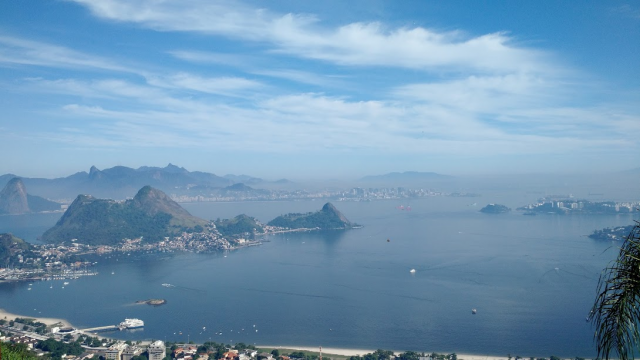Guanabara Bay: waiting for the return of the whales.

Today is Monday morning and I am going to my laboratory in Niteroi by ferryboat. I took it from the XV Square of Rio de Janeiro. I am looking through the window of the ferryboat and I see one of the most beautiful pictures of the city – the Guanabara Bay (GB). Cariocas (people from Rio de Janeiro) use to say that the best tourist attraction of Niteroi is the view of Rio. This joke is not funny for the people from Niteroi, but it is fairly clear for everyone that the view of Rio from the Icaraí beach is spectacular. Moreover, at this exact moment, I am sure that this is true, as my view of the Bay seems to be an amazing postcard.
Dreaming inside this picture from the ferryboat, I am thinking about a conversation that I had with my friend Luiz Carlos Cotovicz Junior (just Junior for his colleagues) about the Guanabara Bay yesterday evening in a churrasco (Brazilian barbeque) after our football match at The Canto do Rio. Junior is a young postdoctoral researcher at the Geochemistry Department of the Chemistry Institute at Fluminense Federal University (UFF). Junior’s research is mainly focused on the study of contamination at the Guanabara Bay. Yesterday at the churrasco I was asking Junior about its contamination. My interest in this subject is as big as the interest of all people who live in Rio and who are in daily contact with the GB (directly or indirectly). Its current polluted state is a sad reality for everyone. The general interest about the Bay was bigger in the last months due to the occurrence of the Olympics (Rio 2016) and my concern is enhanced for the participation of one of my friends in the water competition that would take place in the bay. Javier Torres Del Moral is the coach for the Brazilian Olympic Women Sailing Team and he trains and competes daily in this water.

I was telling Junior that Javier reported some of his and his team’s experiences while training and told me that the pollution in the bay is totally evident. He also said that they found dead dogs, cats, televisions, beds, tons of plastics and waste….all floating in the water. Javier said that sometimes they found big algae proliferation (giving the dark color of the sea). He related also that when the athletes have an injure (for example a cut in the hand or in the leg) they are sure that the injury will be infected fast. Javier said that they had developed a kind of “acquired immunity to the Guanabara Bay’s pollution”, but some of the foregoing Olympic athletes presented skin problems (fungal infections, etc…) as result of the contact with the dirty water. Javier also made an interesting point about how was the bay in the past, with its crystalline waters, white and clean sands, and many wild lives like dolphins, turtles and whales. It was a paradise on earth! A lost urban paradise!
Nowadays, if we have a stroke of luck, we can see a turtle lost between the plastic bottles and bags. Sometimes it is so easy to realize the effects of the time and the human presence in the natural landscape.
As I told you, Junior is a scientist expert on the Guanabara Bay and he confirmed to me the bad state of it. He said that the bay is the second largest on the coast of Brazil and its basin covers 4081 Km2, which represents an important water resource and receptor of effluents. During our conversation, Junior said that the current environmental and sanitary conditions of GB results from the cumulative impacts and environmental changes due to discharge of industrial and urban contaminants into the bay. The high concentration of contaminants lead to the destruction of marine habitats, as well as to several problems to the local fishers and is the cause of important health problems for the population surrounding the area. The attention towards GB pollution increased in the last years and some governmental efforts are being implemented to recover (or at least improve) its water quality. One of the largest actions was the program for remediation of Guanabara Bay that began in 1994, as a collaboration among the Inter-American Development bank, the government of Rio de Janeiro (RJ) and the Japan Bank International Cooperation. This program planned to implement a large set of sewage treatment plants at strategic locations within GB, however, several plants were not concluded and others are not fully functional. The efforts gained new inputs motivated by the Olympics, but unfortunately were insufficient and the GB remains highly contaminated up to this morning.

Importantly, the sanitary conditions of GB and its consequences to marine life and human health were studied by different authors. The GB has an environmental, social and economic importance for the surrounding regions. Its current state endangers wildlife and poses risk to human populations that use this water resource. The group of Prof. Dr. Fabio Thompson from the Federal University of Rio de Janeiro (UFRJ) focused their research1 on the study of pathogenic and toxic microorganism present at the GB and its implication on the higher trophic levels. The GB waters harbors opportunistic pathogenic microbes capable of harming humans and several other life forms (Javier and his team told us that their injuries infected so fast when they were working at the Bay). This is terrible, because the population of Rio is often in contact with that water given that they bath in it or mainly in nearby oceanic beaches like Copacabana or Ipanema (two of the most well-known beaches in the world).
Additionally, to the study of Professor Thompson, during Junior´s PhD he established that Guanabara Bay presented a spatial and temporal variability in methane (CH4)2 and carbon dioxide (CO2) concentrations and emissions (CH4 and CO2 are important markers of contamination). Temporally, highest CH4 concentrations and emissions were detected in the wet period, following strong precipitation events that can enhance the washout and flush to urban areas, sewage network and polluted rivers. And spatially, the most polluted sector at the neighborhood of the major sewage outlet presented the highest CH4 concentrations. This polluted sector represents only 10% of the total surface area of the bay, but is responsible for half of the total diffusive CH4 flux.
The concentrations and emissions of CH4 in GB are among the highest reported in estuarine emitters worldwide. Taking into account that the eutrophication and pollution in coastal waters will increase especially in tropical regions as the result of anthropogenic pressure, the CH4 emissions also tend to be enhanced in highly disturbed ecosystems. According to the compiled CH4 fluxes, urban pollution appears as a significant source of CH4 to the estuaries and coastal waters.
The high concentration of organic material from the effluents produces a big proliferation of phytoplankton (microalgae). Note that Javier said that sometimes the alga proliferation is so big in the bay that produces a dark coloration in the water.
The high phytoplankton proliferation produces a peculiar phenomenon at the GB related with the CO2 given that normally bays, like the GB, release more CO2 than they consumes. We can compare the release of CO2 with the respiration of an animal and the consumption with the photosynthesis of a plant. In the case of Guanabara, this balance is displaced to the consumption of CO2, and this behavior is different to other similar landscapes 3.
I was very surprised with this data and Junior explained to me that the unbalance was produced by the photosynthesis of the microalgae. The GB presents a high concentration of phytoplankton, due mainly to the high organic matter present (product of the high contamination of the bay).
At that moment I said to Junior that this could be an interesting reason to justify the lack of efforts to clean de GB, mainly because from this point of view the contamination of the bay has a positive effect. The high level of contamination produces big algae proliferation and these algae´s photosynthesis consumes CO2 and produces oxygen (O2), and the production of O2 is very important for the preservation of nature. Junior tried to answer but he soon realized that I was joking, as I know the relation of the production of oxygen and the contamination consequences not only for the ecosystem, but also for tourists and the populations’ health.
Fortunately, Junior said the current sanitary conditions of the GB are not worse than those of other heavily contaminated bays around the world that had been successfully recovered. The GB´s hydrodynamic characteristics allow the bay to recover from contamination, and it has been assumed that it may be possible to restore water quality if domestic and industrial sewage are appropriately treated. We cannot see whales or dolphins at the Guanabara bay today but (fingers crossed) maybe the future will be different.
Finally, we arrived in Niteroi and I went to have a coffee with Javier to congratulate him for the gold medal obtained by his team in the Olympics. Congratulations again Javier!
References
- Fistarol et al., 2015, Front Microbiol., 6, 1232. ↩
- Cotovicz et al., 2016, Limnol. Oceanogr., doi: ↩
- Cotovicz et al., 2015, Biogeosciences,12, 6125. ↩
1 comment
[…] La bahía de Guanabara, en Río de Janeiro, es si no la bahía más contaminada del mundo, sí al menos la más famosa tras las pruebas de vela de las últimas olimpiadas. Gerardo Cebrián informa de sus condiciones reales […]